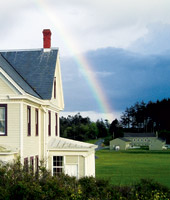 |
|
Autumn 2007 | Volume 30, Number 2
| Campus
|
|
|
Planning Continues for Casey’s Future
Master plan submitted

SPU’s Camp Casey is prized for its natural beauty, rich history, and unique educational and recreational opportunities. |
Seattle Pacific University is proceeding with a master plan for the development of 82 acres of its 300-plus-acre Camp Casey property on Whidbey Island. This follows the establishment by Island County of a new “Existing Master Planned Resort” (EMPR) zoning classification for sites, such as Camp Casey, that meet very specific requirements. Approval in this classification would allow the University to pursue enhancements to Camp Casey aimed at improving year-round use and raising additional revenue needed to operate and maintain the facility on a long-term basis.
In 2003, the University’s plans for making long-range improvements to Camp Casey suffered a setback when Island County’s approval of SPU’s master plan under the “Special Review District” zoning classification was appealed by a conservation group on Whidbey Island. The group raised concerns about a number of issues, including the impact of the proposed development on forested areas. The appeal went to the Western Washington Growth Management Hearing Board, which overturned the County’s original decision. At the same time, it noted that Camp Casey has many of the characteristics of an Existing Master Planned Resort — a zoning designation Island County did not recognize at the time. The County has since taken steps to amend its zoning ordinance to provide for such a status.
The result is that in late September 2007, SPU submitted a master plan and EMPR zoning application to Island County, along with a Forest Management Plan and State Environmental Policy Act checklist.
In revising its master plan, SPU made changes that, while retaining most of the previous plan’s development program, would significantly reduce the impact on Camp Casey’s forest areas. Only three acres out of more than 40 acres of forest would be affected — and only by selective cutting — and no large, old-growth trees removed. The existing trails through the forest areas would be retained with only minor changes, and the beach, bluff, and Crockett Lake areas would not be changed. None of the historic buildings would be demolished or significantly altered in appearance, although improvements would be made to many of the buildings.
Master plan projects include six retreat/seminar buildings, each containing eight housing units and common meeting space; 40 small cabins; a small addition to the Sea Lab; a small addition to Mess Hall B; and a small building to house a wastewater treatment and recycling plant. The major users of the new housing and meeting spaces are expected to be adults and families who are not currently well-served by Camp Casey’s rustic group quarters.
As Seattle Pacific President Philip Eaton expressed in a media release, “Since the beginning of our ownership of Camp Casey, we have worked hard to be good citizens of Whidbey Island, good neighbors, and good stewards of this property. We want to do what is right for this magnificent facility and at the same time ensure the responsible management of our resources. We believe we can meet this challenge and find the right solution, one we all can regard as responsible stewardship.”
A copy of the media release is available by by emailing melaniej@spu.edu.
Back to the top
Back to Campus Home
|
| |
|
 |
|
 |